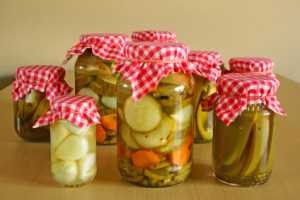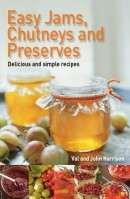Pickles can range from a simple single ingredient pickle to a complex mixed pickle like Piccalilli. The final flavour, especially with the simple pickles, will depend heavily on the vinegar used. See our article on Making Spiced & Flavoured Vinegars, Pickling Vinegars for detailed instructions.
 Pickles require a different processing method to chutney – they do not need to be cooked for such a length of time (with the exception of fruit pickles when the fruit is heated gently to allow the vinegar and spices to penetrate).
Pickles require a different processing method to chutney – they do not need to be cooked for such a length of time (with the exception of fruit pickles when the fruit is heated gently to allow the vinegar and spices to penetrate).
Vegetables used for pickling are first soaked in brine (salt and water solution) or dry salt for up to two days. This preliminary process removes excess moisture in the vegetables, helping them to remain crisp and preventing the development of bacteria. Brine is used for most vegetables but dry salt is better for those with a high water content such as courgettes, marrows and cucumbers.
After salting, the vegetables must be rinsed clean in cold water and well drained before being packed into jars and bottles and covered with vinegar.
The same equipment as for making chutney is required.
Salt, Vinegar and Spices
Types of Salt for Pickling
Block, coarse, sea salt and cooking salt will give a better result than refined table salt that has additives to prevent it going lumpy and often tends to make the pickle cloudy. Iodised salt is not suitable as it has a pronounced flavour.
If brine is to be used to soak the vegetables an average solution is l lb (450 g) to 1 gallon (4.5 litres) – for smaller quantities 100g per litre, of water. The vegetables must be completely covered with the brine and a large plate with a small weight placed on top of them will ensure that the vegetables do not rise and float above the liquid.
For the dry salt method, layer the vegetables with salt in a large bowl, finishing with a layer of salt. Use about a tablespoon (15 ml) of salt to each 1 lb (450 g) of vegetables.
Pickling Vinegar
It’s critical that the vinegar is good quality one with an acetic acid content of at least 5%. Malt vinegar can be bought in its natural brown colour and also as white distilled vinegar. Either can be used but white is normally used when a light-coloured pickle is required. White wine and cider vinegar are suitable for pickling but are more expensive and the more delicate flavour can be overwhelmed in a strong pickle.
Pickling Spices
Spices are added to vinegar to give it a good flavour and they also help as a preservative. Spiced vinegars can be bought but they are easily made. They are at their best if the spices are allowed to steep in the unheated vinegar for 6-8 weeks before the vinegar is used.
Whole spices should be used as ground ones will make the vinegar cloudy.
Don’t place the spices directly into the vinegar, they need to be tied up in a muslin bag/square and steeped in the vinegar. The spices used may be varied depending on the type of pickle and personal taste. Although mixed pickling spice can be bought ready prepared, preparing your own gives a wider variety of flavours for the many different types of pickle.
From Our Pickle Recipes
- Pickled Eggs Recipe
- Sweet Green Pickle Recipe
- Pickled Cucumber Recipe
- Tangy Piccalilli Recipe
- Pickled Red Cabbage Recipe
- Pear Pickle Recipe
- Spiced Pickled Eggs Recipe
- Bread and Butter Pickles Recipe
- Pickled Beetroot Recipe
- Damson Pickle Recipe
More on Preserves
- Fruit Butters & Cheeses
- Fruit Curds – How To Make Fruit Curd
- How to Make Your Own Ketchups & Sauces
- Relishes – How to Make Relishes at Home


